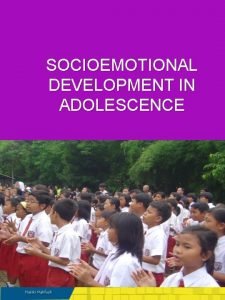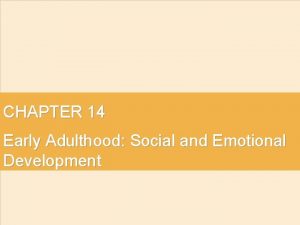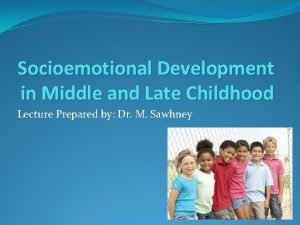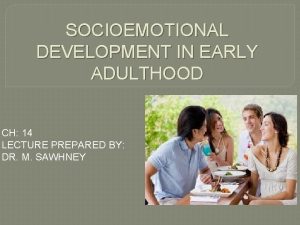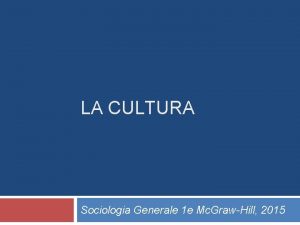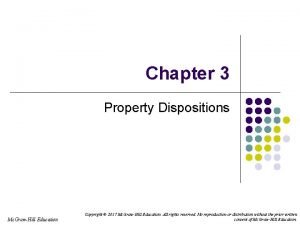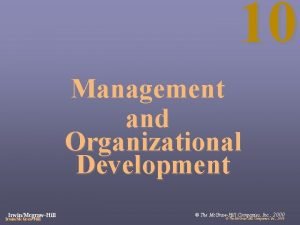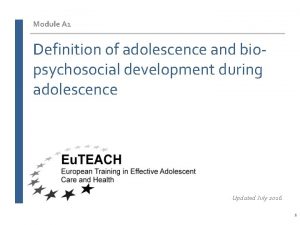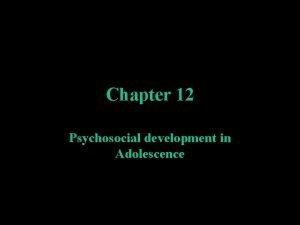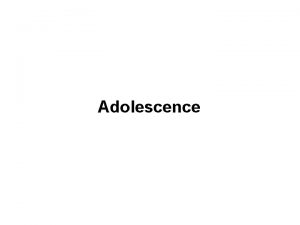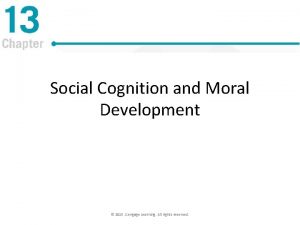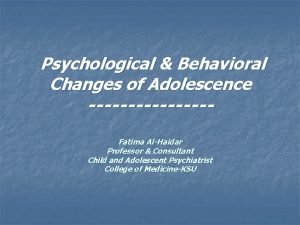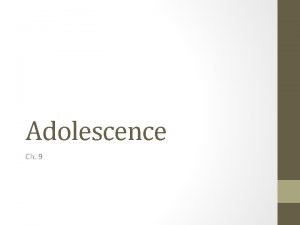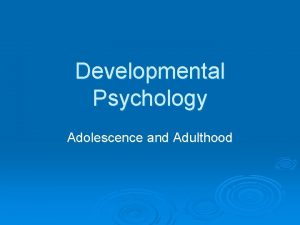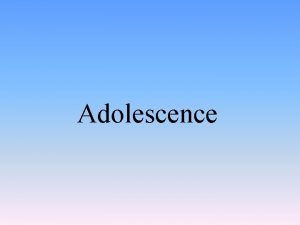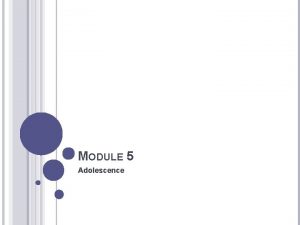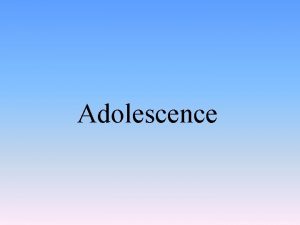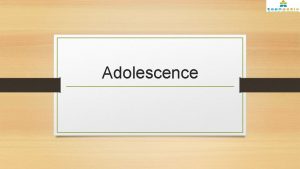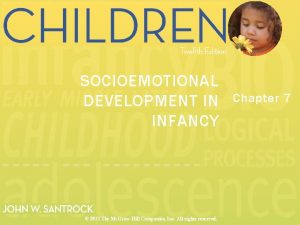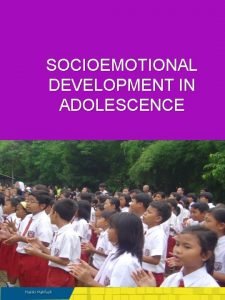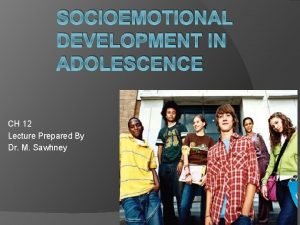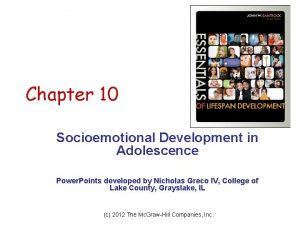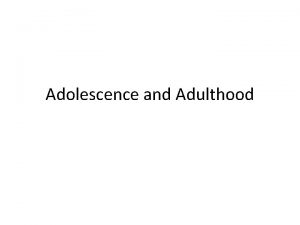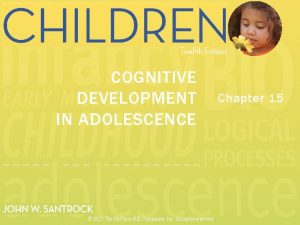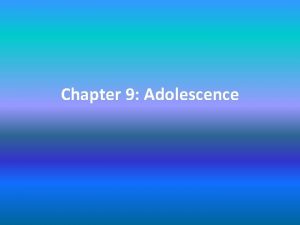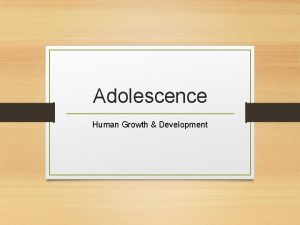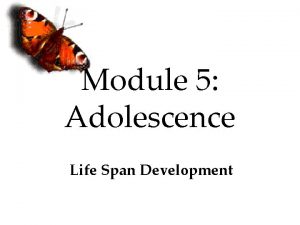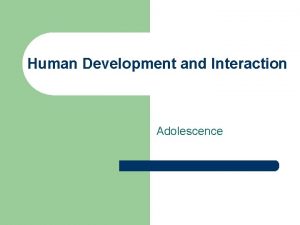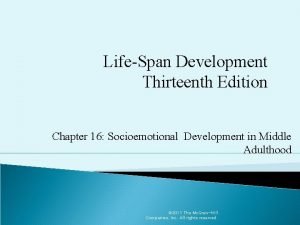SOCIOEMOTIONAL DEVELOPMENT IN ADOLESCENCE 2013 The Mc GrawHill























- Slides: 23

SOCIOEMOTIONAL DEVELOPMENT IN ADOLESCENCE © 2013 The Mc. Graw-Hill Companies, Inc. All rights reserved. Chapter 16

IDENTITY • A self-portrait of many pieces, a synthesis of: • • • Career and work path chosen Political, religious, relationship identities Achievement, intellectual identity Sexual, cultural/ethnic identities Interests, personality, physical identity • A lengthy, complex, lifelong process • Changing and renegotiated © 2013 The Mc. Graw-Hill Companies, Inc. All rights reserved.

IDENTITY • Erikson’s view • Believed to be a key aspect of adolescent development • 5 th stage: Identity vs. identity confusion • Confusion takes two forms: • Self-isolation or lost in the crowd • Identity search aided by psychosocial moratorium – transition, exploratory time © 2013 The Mc. Graw-Hill Companies, Inc. All rights reserved.

IDENTITY • James Marcia • Four statuses of identity inferred in Erikson’s identity • Crisis – period of exploration in identity • Commitment – personal investment © 2013 The Mc. Graw-Hill Companies, Inc. All rights reserved.

MARCIA’S IDENTITY STATUSES © 2013 The Mc. Graw-Hill Companies, Inc. All rights reserved.

IDENTITY • Emerging adulthood and beyond • Key changes likely occur in ages 18 to 25 • College students’ identity more stable in vocational choices than high school students • Not so for religious beliefs, political ideology • College creates increasing complexities • Social commitments • New experiences • Freedoms, self-discipline © 2013 The Mc. Graw-Hill Companies, Inc. All rights reserved.

IDENTITY • Family influences • Individuality within family (2 dimensions) • Self-assertion • Separateness • Connectedness with family (2 dimensions) • Mutuality (sensitivity, respect) • Permeability (openness to other views) • In general, enhances identity formation © 2013 The Mc. Graw-Hill Companies, Inc. All rights reserved.

IDENTITY • Ethnic identity • Sense of membership in ethnic group; also attitudes and feelings related to the group • Influenced by sociocultural contexts • Indicators of identity often differ among generations of immigrants • Existing environmental social factors have impact, such as crime and unemployment © 2013 The Mc. Graw-Hill Companies, Inc. All rights reserved.

EMOTIONAL DEVELOPMENT • More extreme emotions • Emotions more changeable, fleeting • Moodiness is normal • Decrease in overall happiness • Risk of depression • Pubertal changes and environmental experiences linked to negative emotions © 2013 The Mc. Graw-Hill Companies, Inc. All rights reserved.

AUTONOMY AND ATTACHMENT • Push for autonomy • Conflict when adolescents push for autonomy • Parents should relinquish control gradually, as adolescent is able to make reasonable decisions • Gender and culture affect seeking and granting autonomy © 2013 The Mc. Graw-Hill Companies, Inc. All rights reserved.

AUTONOMY AND ATTACHMENT • Role of attachment • Quality of attachment between parents and adolescent has some impact on involvement in problem/risky behaviors • Balancing freedom and control • Parents play important role; monitor and guide, quality relationship and limitations © 2013 The Mc. Graw-Hill Companies, Inc. All rights reserved.

PARENT-ADOLESCENT CONFLICT • Escalated conflict due to • • • Biological changes (puberty) Cognitive changes (idealism, logic) Social changes (independence, identity) Maturational changes Violated expectations • Prolonged conflict is unhealthy • Linked to many behavioral problems © 2013 The Mc. Graw-Hill Companies, Inc. All rights reserved.

FRIENDSHIPS • Sullivan’s ideas stood the test of time • Dramatic increase in psychological importance and intimacy of close friends • Most motivated by popularity with peers • Peers help shape development; increased mutual dependency for many needs • Friends’ character and quality of friendship are important influences • Choice varies among individuals © 2013 The Mc. Graw-Hill Companies, Inc. All rights reserved.

PEER GROUPS • Peer pressure can be negative; most is positive • Recent study of ages 14 to 18 • Important to stand up for own principles • Adolescents conform more to peer standards than younger children do • Resist parental influence stronger in U. S. • Self-esteem can motivate membership © 2013 The Mc. Graw-Hill Companies, Inc. All rights reserved.

PEER GROUPS • Cliques • Average 5 to 6 people • Usually same sex, age • Formed from shared activities, friendship • Crowds • Larger than cliques, more informal • Usually formed based on reputation • May not spend much time together © 2013 The Mc. Graw-Hill Companies, Inc. All rights reserved.

DATING AND ROMANTIC RELATIONSHIPS • Spend considerable time dating, thinking about it • By 10 th grade; about 50% had relationship lasting more than 2 months • By 12 th grade: others did not have relationship lasting 2 months or more • Today, teens find comfort in numbers, hanging out in mixed-sex groups more © 2013 The Mc. Graw-Hill Companies, Inc. All rights reserved.

DATING AND ROMANTIC RELATIONSHIPS • Cyberdating • Alternative to traditional dating • Gay male and lesbian youth • Little research done here • Many hide their orientation • For most: same-sex experience is experiment • Go on to heterosexual orientation later © 2013 The Mc. Graw-Hill Companies, Inc. All rights reserved.

JUVENILE DELINQUENCY • Juvenile delinquent: adolescent who breaks laws, engages in illegal behavior • Broad concept; much higher risks for males • Great increase in female delinquency • Issues of controversy • Adolescent tried as adult; does it reduce crime rates? • States adopting ‘get tough’ policies © 2013 The Mc. Graw-Hill Companies, Inc. All rights reserved.

JUVENILE DELINQUENCY • Causes • Proposed: • Heredity, identity problems, community influences, family experiences • Erikson: restricted social roles, unrealistic expectations for them • More common in lower SES • Lower class culture promotes it? © 2013 The Mc. Graw-Hill Companies, Inc. All rights reserved.

JUVENILE DELINQUENCY • Causes • Lower cultural gangs and peers? • Antisocial gangs, counterproductivity • Neighborhoods have higher crime rates • Criminal role models • Personal, family problems • Unemployment, lack of employment skills, dysfunctional family, poor parenting, etc. © 2013 The Mc. Graw-Hill Companies, Inc. All rights reserved.

DEPRESSION • Females experience and express it more than males for various reasons • Family factors put some youth at risk • Peer relationships linked to depression • Romantic relationships increase risks • Onset in early adolescence linked to negative outcomes later • Most treatments include medications © 2013 The Mc. Graw-Hill Companies, Inc. All rights reserved.

SUICIDE • Rare in childhood, risks increase with age • Third leading cause of adolescent death; emerging adults at risk 3 times more than adolescents • Suicidal peers is influential factor • Threats should be viewed seriously • Gay males and lesbians at highest risk • Females use pills, cut wrists • Males use lethal means © 2013 The Mc. Graw-Hill Companies, Inc. All rights reserved.

INTERRELATION OF PROBLEMS AND SUCCESSFUL PREVENTION/INTERVENTION • 4 problems affecting adolescents most: • • Drug abuse Juvenile delinquency Sexual problems School-related problems • In the U. S. : • Estimated 10% engage in above behaviors © 2013 The Mc. Graw-Hill Companies, Inc. All rights reserved.
 ________ is a self-portrait composed of many pieces.
________ is a self-portrait composed of many pieces. Socioemotional development in infancy
Socioemotional development in infancy Social and emotional development in late adulthood
Social and emotional development in late adulthood Emotional development in early adulthood
Emotional development in early adulthood Late childhood
Late childhood Socioemotional development in early adulthood
Socioemotional development in early adulthood Social development in middle adulthood
Social development in middle adulthood Grawhill
Grawhill Grawhill
Grawhill 作業管理精簡版13版解答
作業管理精簡版13版解答 Grawhill
Grawhill Mc graw hill
Mc graw hill Single user multitasking os
Single user multitasking os Grawhill
Grawhill Mc grawhill
Mc grawhill Grawhill
Grawhill Health model
Health model Moral development in adolescence
Moral development in adolescence Middle adolescence physical development
Middle adolescence physical development Psychosocial development in adolescence
Psychosocial development in adolescence Physical development
Physical development Moral development in adolescence
Moral development in adolescence Moral development in adolescence
Moral development in adolescence Emotional development in adolescence
Emotional development in adolescence
